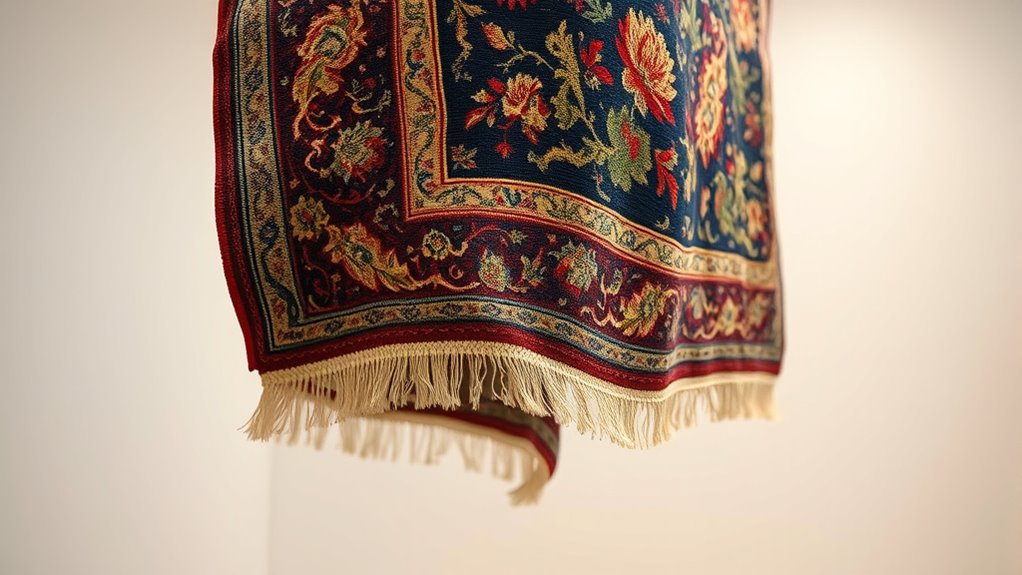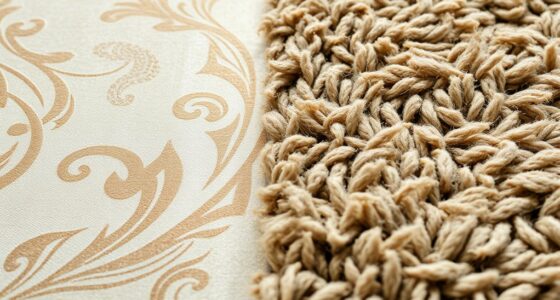To safely hang antique rugs as art, assess their condition first, repairing frayed fringes and strengthening backing if needed. Choose a sturdy, non-invasive mounting system and attach the rug to a supportive backing, like acid-free linen, for added stability. Select a suitable wall location with even lighting, avoiding direct sunlight. Use museum-quality hardware to distribute weight evenly, and guarantee proper installation to prevent damage. For detailed tips, continue exploring how to showcase your rug beautifully and safely.
Key Takeaways
- Assess and restore the rug’s condition to ensure structural integrity before mounting.
- Choose a sturdy wall with appropriate lighting and environmental conditions to prevent damage.
- Use museum-quality, non-invasive mounting methods and hardware to evenly support the rug.
- Properly clean, flatten, and reinforce the rug with acid-free backing for even display.
- Install adjustable lighting to highlight the rug’s patterns while protecting it from UV and heat damage.
Assessing Your Antique Rug’s Condition and Suitability for Wall Display

Before hanging an antique rug as art, it’s essential to evaluate its condition and determine if it’s suitable for wall display. Check the fringe preservation, as frayed or loose fringes may need stabilization to prevent further damage. Examine the rug’s backing for any signs of weakness or tears that could compromise its integrity when hung vertically. Reinforcing the backing with appropriate materials can help provide extra support, reducing the risk of sagging or tearing. Look for any discoloration, stains, or moth damage that might affect its visual appeal or stability. Ensuring the rug is clean and free of pests is vital. Proper assessment helps you decide whether the rug is ready for display or if professional restoration is necessary to preserve its beauty and structural integrity.
Choosing the Right Location and Lighting for Hanging Rugs
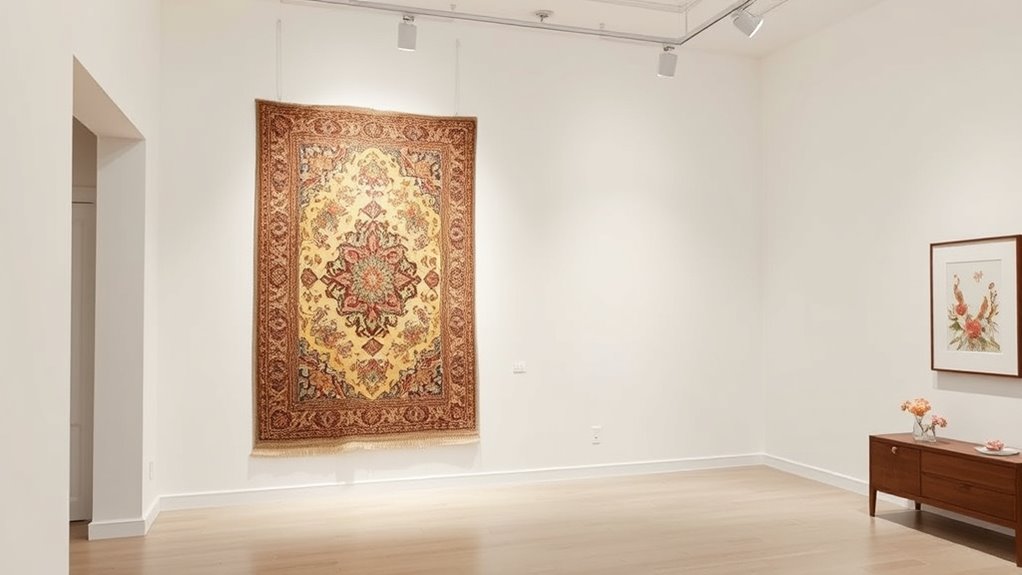
Choosing the right spot on your wall is key to showcasing your antique rug beautifully. You’ll want to contemplate areas with even, unobstructed lighting that highlights the rug’s details without causing damage. Avoid placing it where direct sunlight can fade the colors or weaken the fibers over time. Considering lighting optimization can further enhance the rug’s visual appeal and longevity. Additionally, selecting a location with proper humidity levels helps preserve the rug’s materials and prevents deterioration. Maintaining consistent temperature conditions can also contribute to maintaining the rug’s integrity over time. Incorporating professional hanging methods ensures the rug stays securely mounted and reduces potential damage.
Optimal Wall Placement
Selecting the ideal spot for hanging your antique rug is essential to showcasing its beauty and preserving its condition. Consider these factors to ensure maximum placement:
- Color coordination: Choose a wall color that complements the rug’s hues, making its patterns stand out. Using neutral tones can help the rug’s intricate designs become the focal point of the room.
- Cultural significance: Hang the rug in a space that respects its origins, enhancing its story and value.
- Visibility and balance: Position the rug at eye level or slightly above, ensuring it’s the focal point without overpowering the room. Proper lighting can accentuate its details and craftsmanship, especially when using specialized lighting techniques designed for artworks. Additionally, lighting placement plays a crucial role in highlighting the rug’s textures and colors effectively.
- Security measures: Ensure the wall is sturdy enough to support the weight of the rug, preventing accidental falls or damage cybersecurity vulnerabilities.
- Environmental considerations: Avoid walls with direct sunlight or humidity, which can damage delicate fibers. Proper placement not only highlights your rug’s intricate details but also respects its cultural background, creating a meaningful display that lasts.
Effective Lighting Techniques
Proper lighting can make your antique rug truly stand out, highlighting its intricate patterns and rich colors. To achieve this, consider a combination of ambient lighting and spotlighting techniques. Ambient lighting provides a soft glow that evenly illuminates the space without causing glare, while spotlights focus intense light directly on the rug’s surface, emphasizing details. Position your lights to avoid harsh shadows or reflections that could distract from the artwork. Use adjustable fixtures to fine-tune angles and brightness. Here’s a quick guide:
| Lighting Type | Best Placement | Effect |
|---|---|---|
| Ambient Lighting | Ceiling or wall-mounted | Soft, overall illumination |
| Spotlights | Slightly above and angled | Highlight patterns and textures |
| Dimmer Switches | On ambient and spotlights | Control light intensity |
| LED Lights | Energy-efficient, adjustable | Reduce heat damage |
Additionally, consider the cultural context of your space, as lighting choices can influence the overall ambiance and perception of your antique rug. Properly positioned lighting can help you create the perfect display environment that enhances the rug’s aesthetic appeal. Incorporating appropriate lighting techniques can further help you optimize the viewing experience and protect delicate fibers over time. Using modern lighting options can also minimize heat exposure and safeguard your antique rug’s longevity.
Avoiding Sun Damage
Since sunlight can cause irreversible fading and deterioration of antique rugs, it’s essential to choose their placement carefully. To minimize sun damage, consider these steps: 1. Assess fiber composition to determine how sensitive your rug is to light. Natural fibers like wool or silk may fade faster than synthetic blends. 2. Perform colorfastness testing in an inconspicuous area before hanging the rug in direct sunlight. This helps ensure colors won’t bleed or fade over time. 3. Select a location with limited direct sunlight or use UV-protective window coverings to shield the rug from harmful rays. This approach preserves your antique rug’s vibrant colors and structural integrity for years to come. Additionally, incorporating proper hanging techniques also ensures the rug remains securely mounted without risking damage. Understanding the environmental factors that affect textile preservation can further help in maintaining the quality of your antique rugs, especially considering the impact of air quality and humidity levels on delicate fibers.
Selecting Appropriate Wall Mounting Hardware for Delicate Textiles
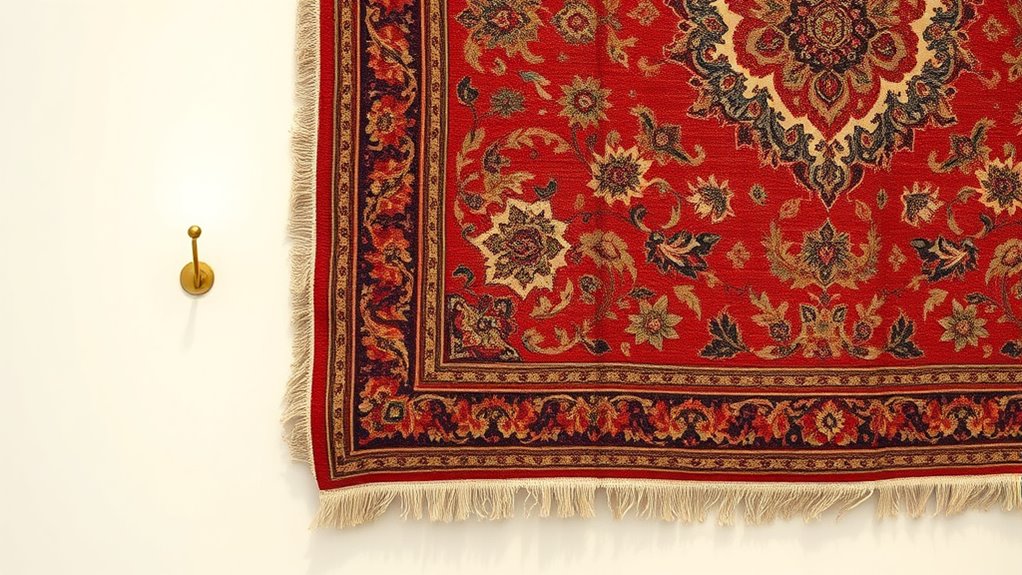
When hanging delicate textiles like antique rugs, choosing the right wall mounting hardware is essential to prevent damage. Wall anchors provide strong support without putting stress on fibers, especially if you’re hanging heavier pieces. Opt for anchors suited to your wall type—drywall, plaster, or brick—to guarantee stability. Adhesive hooks can work for lighter rugs or when you want minimal intrusion; however, select those rated for the weight of your textile. Avoid nails or screws directly into the rug, as they can cause tears. Always verify the weight capacity of your hardware before installation. Proper mounting hardware distributes weight evenly and offers secure support, preserving your antique rug’s integrity while displaying it beautifully.
Preparing Your Rug: Cleaning and Flattening Before Hanging

Before hanging your antique rug, you’ll want to remove dust and debris to safeguard its fibers and preserve its beauty. Use gentle brushing or vacuuming with a soft brush attachment to clean the surface thoroughly. Once clean, employ proper flattening techniques to smooth out creases and ensure your rug lies flat against the wall.
Dust and Debris Removal
Dust and debris can accumulate on your rug over time, so it’s vital to remove them thoroughly before hanging it as art. Proper dust cleaning and debris removal ensure your rug stays pristine and prevents particles from causing damage or discoloration. To do this effectively:
- Use a gentle vacuum with a soft brush attachment to carefully remove surface dust and loose debris.
- Shake the rug outside to dislodge embedded dirt, especially if it’s small or delicate.
- Consider a specialized dusting cloth or a soft brush for detailed cleaning, focusing on fringes and edges.
These steps help eliminate surface contaminants, making your rug ready for display and prolonging its lifespan. Dust cleaning and debris removal are essential in preserving your antique rug’s beauty and integrity.
Flattening Techniques
Ensuring your antique rug is properly flattened is essential for a smooth, professional display. Start by gently unrolling the rug on a clean, flat surface. Use your hands to straighten out the weaving patterns, paying close attention to areas that may have become creased or curled. To preserve the vibrant dyes, avoid excessive moisture or harsh stretching, as these can damage the dye preservation over time. If the rug is stubbornly curled, light weight or gentle steaming can help ease it flat, but never use high heat or direct steam, which might harm delicate fibers. Proper flattening guarantees your rug lays evenly against the wall, highlighting the intricate weaving patterns while maintaining its original colors and integrity.
Creating a Supportive Backing for Added Stability
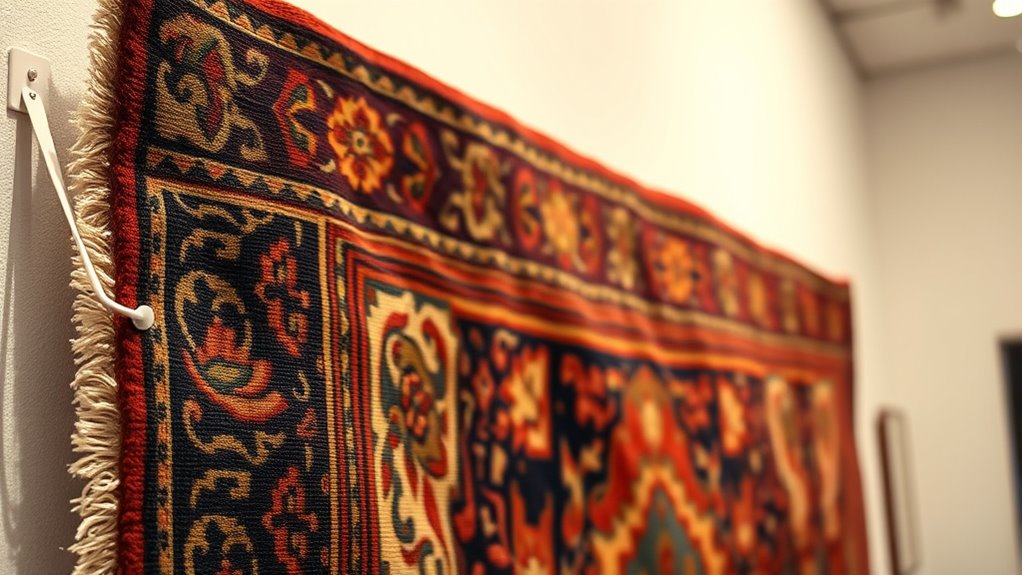
To guarantee your antique rug hangs securely and maintains its shape, adding a supportive backing is crucial. This step provides much-needed stability enhancement, preventing sagging or warping over time. To create an effective backing, consider these three options:
- Use a sturdy, acid-free linen or canvas to preserve the rug’s integrity.
- Attach the supportive backing evenly with a non-invasive adhesive or stitching along the edges.
- Ensure the backing is slightly larger than the rug for thorough support without excess bulk.
This supportive backing acts as a foundation, distributing weight evenly and preventing damage. It’s especially vital for delicate or heavily antique pieces, ensuring they stay beautiful and securely displayed for years to come.
Techniques for Attaching Rugs Safely and Securely
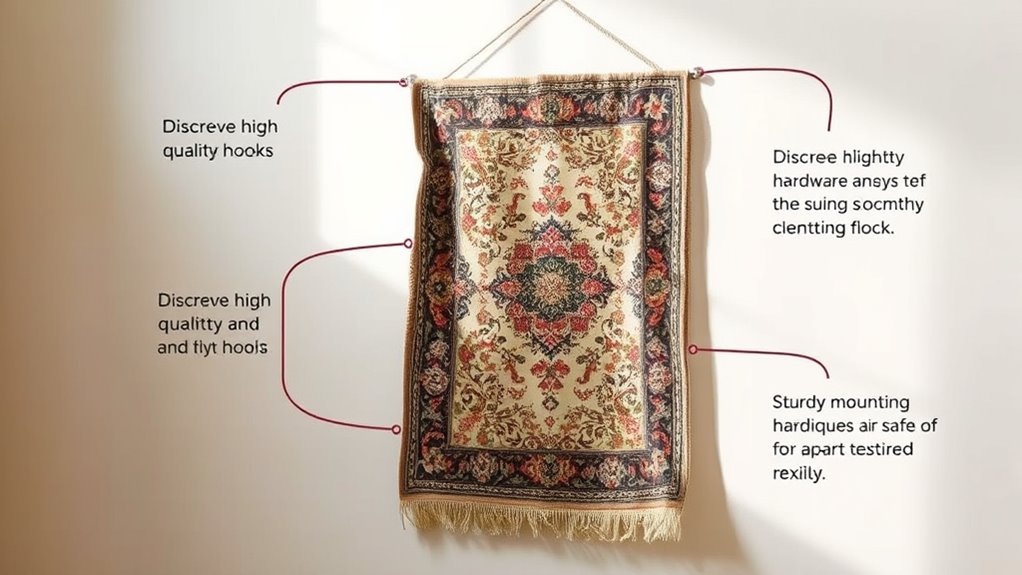
When attaching your antique rug, choosing the right method is essential to keep it secure without causing damage. You have several framing options, like using a sturdy, non-invasive hanging system that distributes weight evenly. Alternatively, you can opt for adhesive choices specifically designed for textiles, such as museum-quality mounting adhesives that won’t harm the rug’s fibers. If you prefer a less invasive method, consider securing the rug with strips of archival tape along the edges, avoiding the pile or delicate areas. Always test your adhesive on a small, inconspicuous section first. The goal is to achieve a firm hold while preserving the integrity of the rug’s antique qualities. Proper technique ensures your rug stays safely displayed without risking damage over time.
Using Framing and Mounting Boards to Protect Your Antique Rug
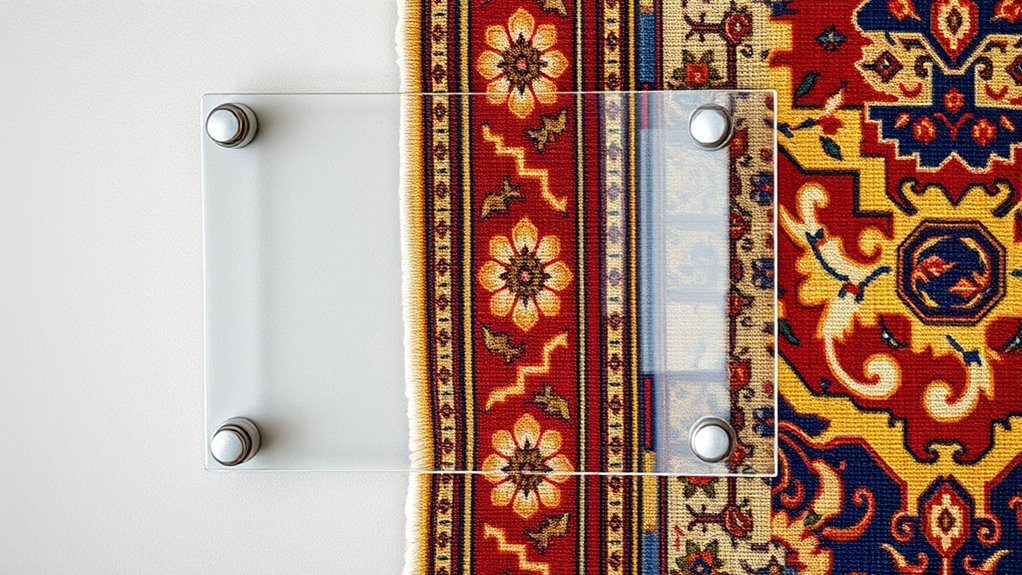
Choosing the right materials for framing and mounting boards is essential to protect your antique rug. Proper mounting techniques guarantee it stays secure without damage, while regular preservation and maintenance keep it looking its best. Let’s explore how to select the best boards and methods to keep your rug safe and beautiful.
Material Selection for Boards
Selecting the right materials for framing and mounting boards is essential to safeguarding your antique rug. Your choice impacts durability, fabric texture, and overall preservation. First, opt for acid-free, museum-quality mounting materials that won’t discolor or damage the rug over time. Second, choose boards made from stable, inert materials like cotton or linen, which won’t react with the fabric or cause deterioration. Third, guarantee the mounting materials are lightweight yet sturdy, providing support without adding unnecessary stress. These considerations help prevent damage caused by acidic components or unstable substances. By carefully selecting compatible materials, you protect your antique rug from potential harm, maintaining its beauty and integrity for years to come.
Proper Mounting Techniques
Proper mounting techniques guarantee your antique rug remains protected and retains its beauty over time. Start by selecting suitable framing options, such as mounting boards, that support the rug evenly and prevent sagging. Use acid-free materials to avoid damage from acidity. When attaching the rug, consider using discreet wall anchors designed to distribute weight evenly and minimize strain on the fabric. Ensure the anchors are appropriate for your wall type to prevent damage. Avoid direct nails or staples through the rug, as they can cause tearing. Instead, secure the mounting board behind the rug, creating a seamless, protective display. Properly anchored and supported, your antique rug will hang safely while showcasing its intricate details for years to come.
Preservation and Maintenance
Have you considered how framing and mounting boards can substantially extend the life of your antique rug? Properly chosen materials protect delicate features like fringes and help maintain dye stability. To maximize preservation:
- Use acid-free, UV-protective mounting boards to prevent color fading and preserve fringes.
- Avoid direct contact with glass to prevent moisture buildup that can damage dyes and fibers.
- Regularly inspect the mounting for signs of deterioration, ensuring the rug remains securely supported without stress.
These steps help prevent deterioration from environmental factors and handling. Framing and mounting boards act as barriers, safeguarding your antique rug’s vibrant colors and intricate fringes, ensuring it remains a cherished piece for generations.
Ensuring Proper Weight Distribution and Avoiding Damage
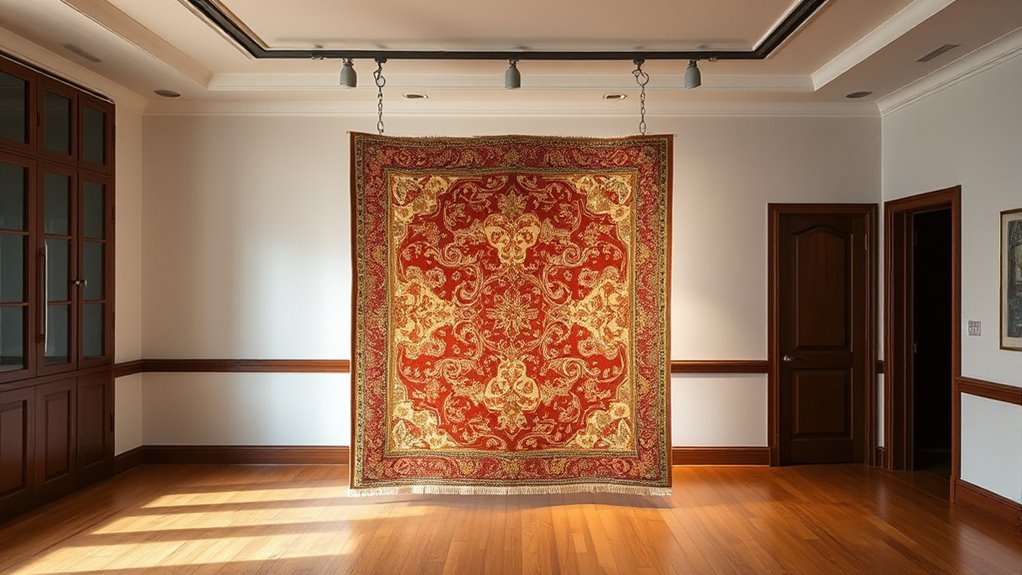
To prevent damage when hanging antique rugs, you need to pay close attention to how the weight is distributed across the hanging surface. Proper weight distribution ensures the rug remains stable and avoids undue stress on any single point. Use a sturdy, well-secured rod or hanging system that supports the entire width of the rug evenly. Avoid focusing on just a few attachment points, as this can cause sagging or tears over time. When installing hooks or nails, make sure they can handle the rug’s weight to maintain hanging stability. Distributing the weight evenly not only preserves the rug’s structural integrity but also reduces the risk of warping or damage to the wall. Prioritize secure, balanced hanging to protect your antique rug’s beauty and longevity.
Regular Maintenance and Inspection of Wall-Hung Rugs
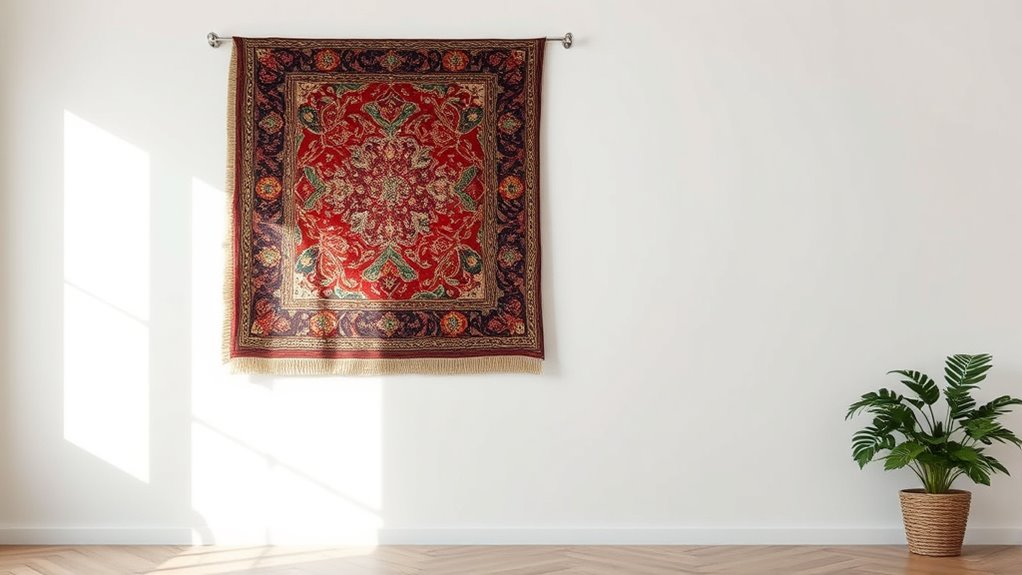
Regular maintenance and inspection are essential to keep your wall-hung antique rugs in pristine condition. Regularly check for signs of wear, fading, or damage to the rug’s weaving techniques, which reveal its craftsmanship and authenticity. Focus on three key areas:
- Inspect for loose or frayed edges to prevent further unraveling.
- Examine the colors for fading or discoloration, which can threaten antique dye preservation.
- Assess the rug’s hanging mechanism to ensure it remains secure and evenly balanced, preventing undue stress on the fibers.
Tips for Showcasing Your Antique Rug as a Focal Art Piece
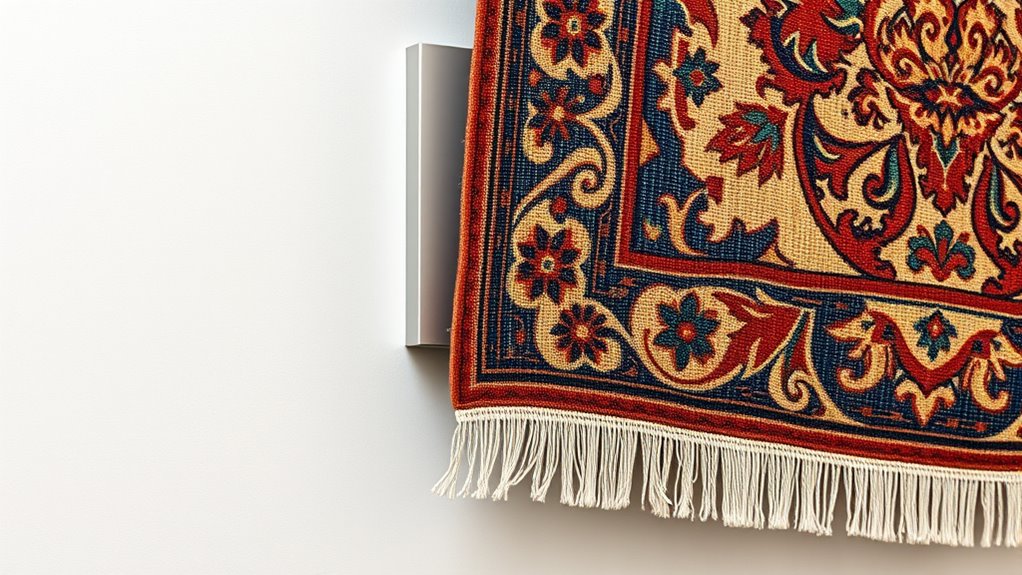
Transforming your antique rug into a striking focal point requires thoughtful presentation. Start by selecting a rug with mesmerizing rug weaving that highlights its craftsmanship and history. Guarantee it’s properly restored through antique restoration to preserve its integrity and colors. Hang the rug at eye level for maximum impact, using a sturdy, well-secured rod that supports its weight evenly. Keep the surrounding space simple to let the rug stand out—avoid clutter or competing decor. Use lighting strategically; soft, focused illumination brings out the details and textures of the rug weaving. Consider framing or mounting the rug on a smooth, clean wall to prevent damage. With these tips, your antique rug becomes a true art piece, drawing admiration and appreciation.
Frequently Asked Questions
How Do I Prevent My Antique Rug From Fading Over Time?
To prevent your antique rug from fading, you should use UV protection, like UV-filtering glass or film on windows, to block harmful sunlight. Proper framing also helps preserve its colors and integrity by providing support and reducing exposure to environmental factors. Keep your rug away from direct sunlight and high humidity, and regularly rotate it if displayed for extended periods. These steps will help maintain its vibrant appearance over time.
Can I Hang a Very Fragile or Heavily Worn Rug Safely?
Think of hanging a fragile, worn rug like balancing a delicate sculpture—you need the right support. You can hang a very fragile or heavily worn rug safely if you use gentle hanging techniques and proper rug preservation methods. Use padded, non-slip rods or custom mounts to avoid stress points. Always consult a professional appraiser or conservator for guidance, ensuring your treasured piece stays secure and undamaged over time.
What Are the Best Ways to Remove Old Hanging Hardware Without Damaging the Rug?
To remove old hanging hardware without damaging your rug, start by carefully inspecting the hardware. Use gentle drilling techniques, like a low-speed drill, to loosen screws without tearing fibers. If adhesive was used, apply a solvent designed for adhesive removal with a soft cloth, avoiding excessive force. Patience is key—take your time to prevent any damage, ensuring your antique rug stays pristine.
How Often Should I Inspect and Maintain My Wall-Mounted Antique Rug?
You might be surprised how often your antique rug needs inspection—every 6 to 12 months is ideal. Regularly check for signs of wear, loose hardware, or damage, ensuring your Rug display techniques and wall mounting safety stay effective. Staying vigilant helps prevent accidents and keeps your treasured piece looking its best. By maintaining a routine, you guarantee your wall-mounted antique rug remains a safe, beautiful focal point in your space.
Are There Specific Wall Colors That Enhance the Appearance of Antique Rugs?
Choosing the right wall color schemes can truly highlight your antique rug. Opt for neutral tones like creams, beiges, or soft grays, which provide a subtle background that allows the rug’s details to stand out. When considering paint selection, avoid overly bright or busy colors that might compete with the rug’s intricate patterns. Instead, select shades that complement and enhance its vintage charm, creating a harmonious and elegant display.
Conclusion
By following these steps, you’ll turn your antique rug into a stunning wall art piece that stands the test of time. Think of it as hanging a priceless tapestry from a royal court, ensuring it stays pristine for generations. With proper care, your treasured heirloom will become a mesmerizing focal point, blending history and artistry in your home. Remember, patience and attention to detail are your best allies—like a skilled artisan in an ancient guild.
